Heart rate watches transform your workouts by providing precise exercise intensity data across five distinct zones. You’ll optimize fat burning in Zones 1-2, build aerobic capacity in Zone 3, and boost anaerobic power in Zones 4-5. These devices offer real-time feedback to adjust your effort instantly, track recovery metrics like HRV, and prevent overtraining. Beyond immediate benefits, they reveal long-term cardiovascular improvements and can even monitor sleep quality. Let’s explore how this technology can revolutionize your fitness journey.
Heart Rate Zones: Unlocking Your Body’s Exercise Potential

While many exercisers focus solely on duration or distance, heart rate zones offer a more sophisticated approach to training.
These zones—ranging from 50% to 100% of your maximum heart rate—correspond to different physiological states and training benefits.
Your heart rate watch can classify your effort into five distinct zones:
- Zone 1 (50-59%) for recovery,
- Zone 2 (60-69%) for fat metabolism,
- Zone 3 (70-79%) for aerobic conditioning,
- Zone 4 (80-89%) for improving lactate threshold,
- Zone 5 (90-100%) for anaerobic power.
Lower intensity zones like Zone 1 through Zone 3 are particularly effective for burning fat calories while building endurance.
Real-Time Feedback: Adjusting Workout Intensity On The Go
One of the most transformative features of modern heart rate watches is their ability to provide instant feedback as you exercise. This real-time data allows you to make immediate adjustments to your workout intensity, ensuring you’re always in the ideal zone for your goals.
When your watch shows you’re working too hard or not hard enough, you can modify your pace or effort accordingly. This creates an efficient feedback loop that maximizes your training effectiveness.
Whether you’re running, cycling, or strength training, your heart rate monitor continuously transmits accurate data to help you maintain the right intensity level.
Your heart rate monitor becomes your personal coach, signaling precisely when to push harder or dial back during any workout.
This instant feedback not only improves workout efficiency but also keeps you motivated as you see your body responding to different exercise intensities, helping you achieve your fitness goals faster. Staying in specific heart rate zones allows you to optimize fat burning during your workouts while preventing overexertion.
Preventing Overtraining: Signs Your Watch Can Detect
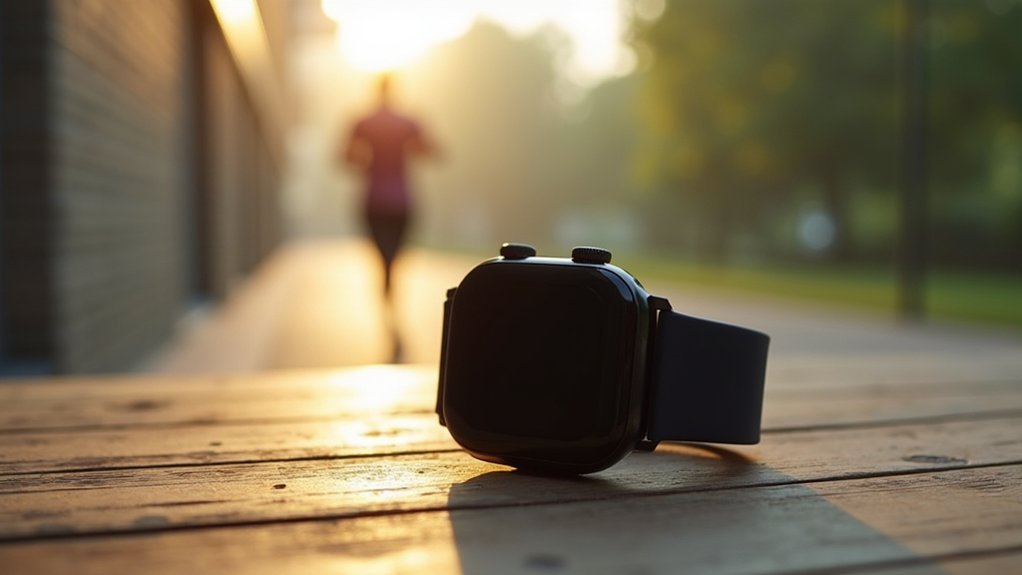
Modern heart rate watches can detect overtraining through abnormal heart rate variability patterns that signal your body’s stress response.
Your watch might also alert you to unusual recovery patterns when your heart rate doesn’t return to normal as quickly as it should after workouts.
Poor sleep quality indicators tracked by your device—including disrupted sleep cycles and elevated nighttime heart rates—further warn you’re pushing too hard and need additional recovery time.
Research suggests a decline in HRV for a period longer than 3-4 weeks may indicate you’re experiencing overtraining syndrome and should adjust your training regimen accordingly.
Heart Rate Variability Warnings
As athletes push their physical limits, heart rate variability (HRV) has emerged as an essential metric for preventing overtraining syndrome. Your heart rate watch can track the millisecond variations between heartbeats, revealing vital information about your autonomic nervous system balance.
When you establish your personal HRV baseline through consistent monitoring, you’ll notice warning signs before overtraining sets in. A sustained drop in HRV below your normal range serves as a yellow flag, suggesting you should reduce training intensity. Regular monitoring helps identify when your body needs lighter training sessions during periods of decreased readiness.
If your HRV falls markedly (beyond one standard deviation), consider it a red flag requiring recovery time.
This non-invasive monitoring method allows you to make data-driven training decisions daily. By responding to these HRV warnings, you’ll maintain training consistency, reduce injury risk, and optimize performance without succumbing to the pitfalls of overtraining.
Unusual Recovery Patterns
Your heart rate watch can identify subtle recovery anomalies long before physical symptoms manifest. When your resting heart rate remains consistently elevated, it’s a clear warning that your body isn’t recovering properly.
Similarly, declining heart rate variability signals decreased parasympathetic activity—a classic overtraining indicator.
Pay attention to prolonged periods in high-intensity zones and unexpected heart rate spikes during routine activities. These patterns suggest your system is under excessive stress.
If your heart rate doesn’t return to baseline within normal timeframes after exercise, you’re likely overreaching. This real-time monitoring of recovery patterns is similar to how wearable technology assists individuals in addiction recovery programs by tracking physiological responses to stressors.
Modern watches use advanced algorithms and machine learning to detect these unusual patterns, providing real-time feedback when recovery isn’t ideal.
Sleep Quality Indicators
Sleep quality represents one of the most revealing metrics your heart rate watch monitors, offering critical insights into your recovery status and potential overtraining risks.
Your device tracks key indicators like heart rate variability, oxygen levels, and movement patterns throughout the night.
Lower average heart rates during sleep typically signal better recovery, while frequent wakings may indicate stress or overtraining.
Many watches now analyze your sleep stages—light, deep, and REM—providing a thorough picture of recovery quality. Some advanced sensors can even track your sleep phases with precise percentages (Deep 28%, REM 16%, Light 46%) to help identify sleep depth patterns.
This data helps you identify when your body hasn’t fully recovered.
Optimizing Caloric Burn Through Targeted Heart Rate Training
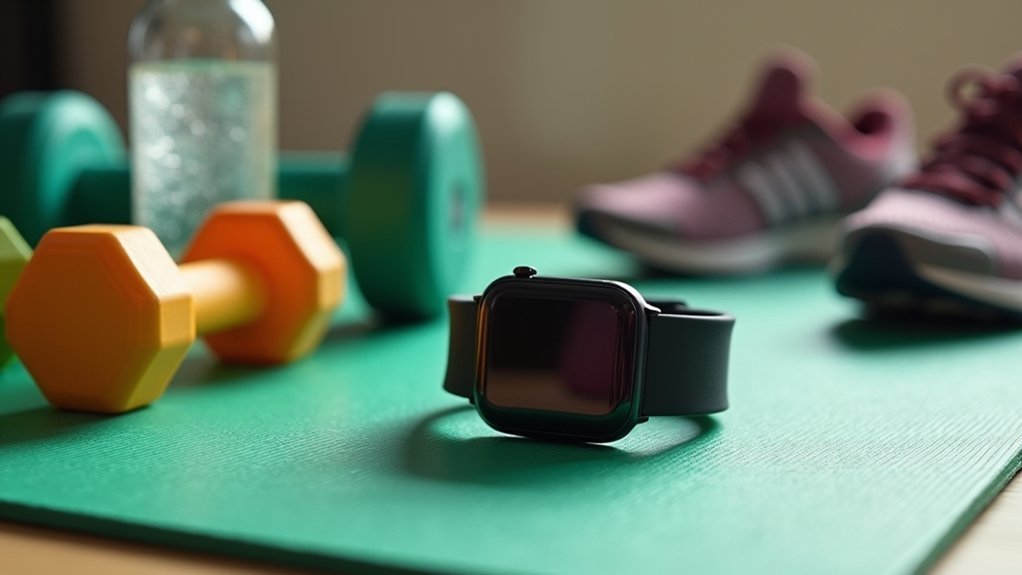
Your heart rate watch reveals the secret to maximizing calorie burn through distinct cardiovascular zones.
By tracking time spent in fat-burning zones (60-70% max HR) versus high-intensity zones (>85% max HR), you’ll optimize both fat oxidation and overall energy expenditure. However, be cautious about making dietary decisions based on the energy expenditure data from your device, as studies show even the most accurate trackers can be off by at least 27%.
HIIT workouts that alternate between these heart rate zones deliver exceptional caloric efficiency while producing valuable cardiovascular adaptations that continue burning calories hours after you’ve finished exercising.
Burn Zones Matter
Precision in training creates remarkable differences in workout efficiency and caloric burn. By targeting specific heart rate zones, you’ll maximize your results based on your fitness goals. Zone 2 training (60-70% of max HR) enhances fat burning while improving endurance and aerobic capacity. A tailored exercise plan based on heart rate zones significantly increases your chances of achieving desired fitness outcomes.
| Zone | Intensity (% Max HR) | Primary Benefit | Best For |
|---|---|---|---|
| 1 | 50-60% | Recovery | Warm-up/Cool-down |
| 2 | 60-70% | Fat burning | Weight management |
| 3 | 70-80% | Aerobic fitness | Endurance improvement |
| 4 | 80-90% | Performance | Speed & power |
Your heart rate watch provides real-time feedback to keep you in the ideal zone. While higher zones burn more total calories, Zone 2 burns the highest percentage from fat sources, making it perfect for weight loss goals.
HIIT Heart Benefits
While traditional steady-state cardio has its place, High-Intensity Interval Training (HIIT) delivers exceptional cardiovascular benefits that maximize caloric burn through strategic heart rate manipulation.
By targeting heart rates between 80-95% of your maximum during intense intervals, you’re training your heart to become more efficient at pumping blood. Research shows HIIT can enhance cardiovascular fitness more quickly than longer, moderate-intensity workouts.
HIIT’s cardiovascular advantages include:
- Improved VO2 peak and left ventricular output, particularly beneficial for those with heart conditions
- Increased nitric oxide availability by 36%, enhancing blood circulation throughout your body
- Reduced risk factors for heart disease while requiring considerably less time than traditional workouts
Your heart rate watch becomes invaluable during HIIT sessions, helping you maintain the ideal intensity that transforms your cardiovascular system.
This targeted approach enables you to achieve impressive fitness gains in shorter workout sessions.
Personalized Fitness Assessments Using Heart Rate Data
As wearable technology continues to evolve, personalized fitness assessments have become increasingly sophisticated through the integration of heart rate data. Your heart rate watch doesn’t just count beats—it captures your unique cardiovascular profile, revealing insights about your fitness level. Digital tools like heart rate watches streamline the assessment process and enhance accuracy while providing immediate feedback.
By analyzing your heart rate kinetics—how quickly your heart responds to intensity changes and recovers afterward—these devices can assess your cardiovascular fitness with remarkable accuracy. Faster recovery and moderate increases during exercise typically indicate higher fitness levels.
Modern wearables combine physiological principles with machine learning to predict how your body will respond to specific workouts. This enables tailored exercise recommendations based on your actual capacity rather than generic formulas.
You’ll receive customized insights that help identify subtle fitness improvements and potential warning signs of overtraining or health concerns.
Recovery Metrics: What Your Heart Rate After Exercise Reveals
Your heart rate doesn’t just matter during exercise—it tells an equally compelling story afterward.
Heart rate recovery (HRR) measures how quickly your pulse drops after you stop exercising, revealing significant insights about your cardiovascular health and fitness level.
Modern heart rate watches track this essential metric automatically, showing you:
- How effectively your autonomic nervous system shifts from sympathetic to parasympathetic control
- Your body’s adaptation to exercise demands and overall fitness level
- Potential cardiovascular risk factors that might otherwise remain hidden
The faster your heart rate returns to normal, the better your fitness level. For a standardized measure, you can count your heart rate at the end of exercise and again one minute later, with the difference being your HRR value.
By monitoring this recovery pattern over time, you’ll gain valuable feedback about your training effectiveness.
Your post-exercise heart rate isn’t just a number—it’s a window into your body’s resilience and adaptability.
Training Efficiency: Maximizing Results With Minimal Time
Time is the most precious resource for today’s fitness enthusiasts, making heart rate watches indispensable tools for efficient training. These devices provide accurate intensity monitoring across various exercise levels, helping you optimize every minute of your workout.
By understanding your maximum heart rate zones, you’ll train smarter—beginners at 50-65%, intermediates at 60-75%, and advanced exercisers at 70-85%. This precision prevents both undertraining and overexertion, maximizing energy expenditure while minimizing injury risk.
Training within your specific heart rate zone unlocks efficient fitness progress while safeguarding your body from unnecessary strain.
Heart rate data enables you to create customized training plans with focused high-intensity intervals and strategic recovery periods. You’ll adapt your regimen based on real-time physiological responses, ensuring efficient progression. The delayed response of heart rate to changes in exercise intensity makes predictive models particularly valuable for optimizing your training.
The result? Time-saving workouts that deliver superior results compared to traditional methods, letting you achieve your fitness goals faster.
Heart Rate Variability: The Window To Your Body’s Stress Levels
Your heart rate variability reveals key recovery patterns after workouts, showing if you’ve returned to baseline or still need rest.
Modern watches can provide real-time stress indicators by tracking HRV throughout your day, allowing you to identify when your body enters fight-or-flight mode.
You’ll gain immediate feedback on how your body responds to stressors like intense exercise, poor sleep, or work pressure—enabling smarter training decisions.
High variability generally indicates better autonomic nervous system function, suggesting your body is effectively balancing between stress and recovery states.
HRV Recovery Patterns
Heart rate variability (HRV) serves as a powerful window into your body’s stress and recovery status, revealing how effectively you’re adapting to training demands.
Your modern heart rate watch tracks these complex patterns, giving you insights into your physiological state that were once only available in labs.
Different exercise types create distinct recovery signatures:
- Interval training typically results in slower parasympathetic recovery compared to steady-state workouts
- The first hour post-exercise shows significant HRV fluctuations based on your workout intensity
- Long-term HRV recovery depends more on total exercise volume than exercise type
Research shows that higher blood lactate concentration is strongly associated with delayed HRV recovery in adolescents following intense exercise.
Real-time Stress Indicators
Modern heart rate watches transform how we comprehend our body’s stress response by monitoring heart rate variability (HRV) in real time. Your watch provides immediate feedback on autonomic nervous system functioning, revealing how effectively you’re handling both physical and mental stressors. For optimal tracking, it’s recommended to measure your HRV for at least five minutes each session to get reliable data.
| HRV Reading | Stress Level | Recommended Action |
|---|---|---|
| High HRV | Low stress | Continue normal activities |
| Declining HRV | Increasing stress | Consider stress management techniques |
| Low HRV | High stress | Reduce training intensity |
| Fluctuating HRV | Variable stress | Monitor external stressors |
| Consistently low | Chronic stress | Prioritize recovery and sleep |
Comparing Chest Straps vs. Wrist-Based Monitoring Accuracy
When choosing between heart rate monitoring options, understanding the accuracy differences between chest straps and wrist-based devices is essential. Chest straps use electrocardiography (ECG) technology, measuring electrical signals directly from your heart with up to 99.6% accuracy.
Heart rate accuracy matters—chest straps capture your heart’s electrical signals with near-perfect precision, outperforming wrist alternatives.
Meanwhile, wrist-based monitors use optical sensors that are more susceptible to environmental factors.
For your training needs, consider these key differences:
- Chest straps maintain consistent accuracy during high-intensity workouts, while wrist-based monitors often lose precision as exercise intensity increases.
- Environmental factors like ambient light and moisture greatly affect wrist monitors but have minimal impact on chest straps.
- Wrist-based options offer superior comfort for long-duration activities, which might outweigh accuracy concerns for casual fitness enthusiasts.
Research by Pasadyn et al. demonstrated that the Apple Watch III achieved 0.96 agreement with ECG readings during treadmill running, making it the most accurate wrist-based option for runners.
Tracking Long-Term Cardiovascular Improvements
Tracking your cardiovascular improvements over weeks and months offers valuable insights that single workout measurements simply can’t provide. Regular monitoring reveals meaningful trends like reduced resting heart rate and improved Heart Rate Variability (HRV), both recognized biomarkers for cardiovascular health.
With consistent exercise, you’ll likely notice your resting heart rate decrease while your cardiac output and oxygen uptake increase. The growing public interest in health-focused measurements has driven manufacturers to expand their devices’ capabilities beyond basic exercise markers. Heart rate watches enable you to document these changes objectively rather than relying on subjective feelings.
Long-term monitoring also helps you establish personalized target exercise intensities based on your actual cardiac capacity. The data collected becomes particularly valuable when paired with lifestyle modifications like dietary changes.
Together, these improvements support better vascular health and oxygen delivery throughout your body, creating sustainable cardiovascular benefits that extend well beyond fitness alone.
Heart Rate Monitoring For Special Health Conditions
People with special health conditions find heart rate watches particularly valuable for managing their unique cardiovascular needs. If you’re living with atrial fibrillation or other arrhythmias, these devices can detect irregular heartbeat patterns, enabling earlier intervention when symptoms arise.
Heart rate monitors empower patients with arrhythmias to detect irregularities early and take proactive control of their cardiovascular health.
For those with cardiovascular concerns, monitoring offers several advantages:
- Tracks patterns of irregular heartbeats, providing valuable data to share with your healthcare provider
- Helps manage risk factors, as elevated resting heart rates correlate with increased cardiovascular disease risk
- Allows you to monitor your response to medications and lifestyle changes in real-time
Heart rate watches can help distinguish between normal variations and concerning heart rate changes that might indicate potential health problems.
Remember that while consumer devices are increasingly sophisticated, they should complement rather than replace professional medical care.
Always discuss your monitoring results with your healthcare provider for proper evaluation and treatment guidance.
Sleep Quality Assessment Through Overnight Heart Rate Patterns
Beyond monitoring your active heart rate, modern heart rate watches offer valuable insights during your sleeping hours as well. Your heart rate patterns overnight can reveal important indicators about sleep quality without invasive testing.
These devices analyze heart rate variability (HRV), which reflects autonomic nervous system activity during different sleep stages. Higher HRV typically indicates better sleep quality and recovery, while decreased HRV may signal poor sleep or stress.
Your watch can detect changes between sleep stages by identifying characteristic heart rate patterns, achieving up to 66% accuracy in identifying five distinct sleep stages. This non-invasive monitoring helps identify potential sleep disorders and can contribute to better overall health management.
It’s especially useful for those with cardiovascular concerns, as poor sleep quality often correlates with increased heart health risks. Research among medical students in Brazil demonstrates that poor sleep quality is significantly associated with reduced HRV values, potentially indicating negative impacts on cardiovascular health.
Integrating Heart Rate Data With Other Fitness Metrics
While heart rate monitoring provides valuable insights on its own, integrating this data with other fitness metrics creates a more thorough picture of your overall health and performance.
Heart rate data shines brightest when combined with other metrics, creating a comprehensive view of your fitness journey.
This holistic approach helps overcome the limitations of using heart rate as a standalone measurement.
For ideal training outcomes, consider combining your heart rate data with:
- Power output measurements – especially beneficial for cyclists and runners who need objective work rate metrics beyond cardiovascular response
- Ventilatory threshold testing – creates more accurate training zones that heart rate alone can’t precisely identify
- Perceived effort ratings – adds subjective experience to balance the objective data, accounting for daily variations in fatigue and stress
Advanced wearables now facilitate this integration, using machine learning to provide real-time feedback for immediate workout adjustments. This technology has shown significant impact in providing personalized fitness recommendations based on individual responses to exercise intensity.
Frequently Asked Questions
Can Heart Rate Watches Interfere With Medical Devices Like Pacemakers?
Yes, your heart rate watch can interfere with pacemakers due to its magnetic components and electromagnetic signals. You’ll need to keep it at least six inches away from medical devices and consult your doctor beforehand.
How Often Should Heart Rate Monitors Be Recalibrated?
You don’t need to recalibrate most heart rate monitors regularly. Check your device’s performance periodically, especially after software updates or if you notice inconsistent readings. Consult your specific model’s manual for recommendations.
Are Waterproof Heart Rate Watches Accurate During Swimming Workouts?
Waterproof heart rate watches aren’t as accurate while swimming. Wrist-based monitors struggle underwater due to water interference. You’ll get better results with chest straps or specialized devices like the Polar OH1+ attached to goggles.
Do Medications Affect Heart Rate Watch Readings?
Yes, medications can affect your heart rate watch readings. Cardiovascular drugs and ADHD medications particularly impact accuracy by altering your actual heart rate, rhythm, and blood flow patterns that optical sensors detect.
Can Children Safely Use Heart Rate Watches for Sports?
Yes, your children can safely use heart rate watches for sports with your supervision. They’re beneficial for tracking intensity and preventing overexertion, but consult a doctor if your child has existing heart conditions.
In Summary
Your heart rate watch isn’t just a timepiece—it’s your personal fitness guide. By tracking your heart’s response to exercise, you’ll train smarter, recover better, and achieve more specific goals. Whether you’re preventing overtraining, managing health conditions, or optimizing calorie burn, this technology transforms abstract effort into measurable data. Embrace this tool to understand your body’s signals and you’ll reveal new levels in your fitness journey.


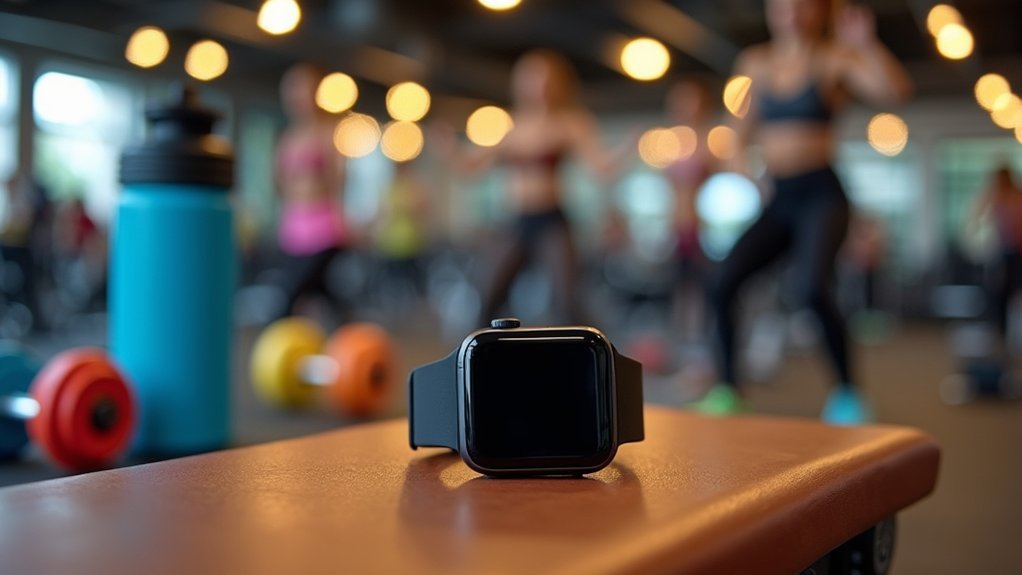
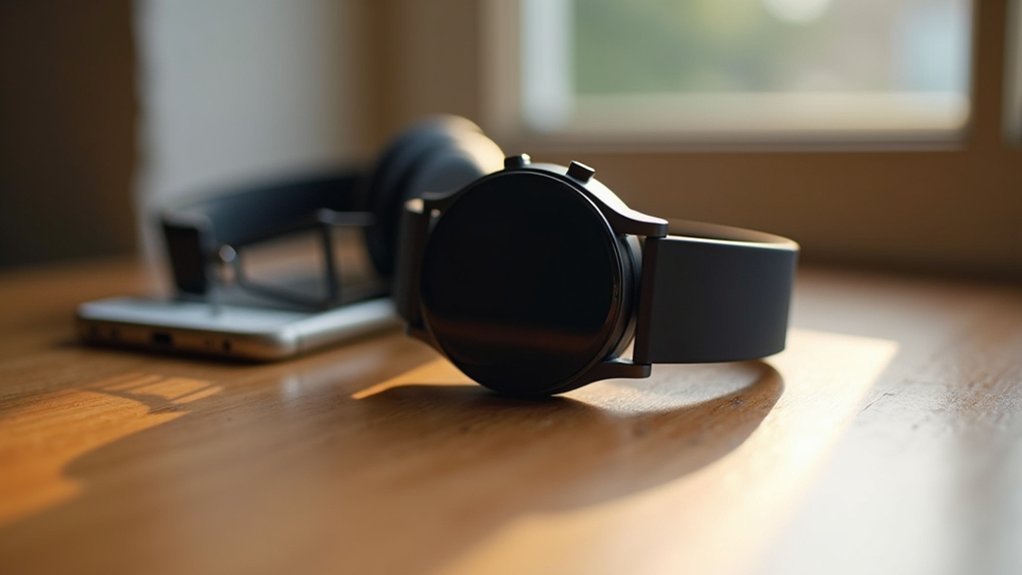
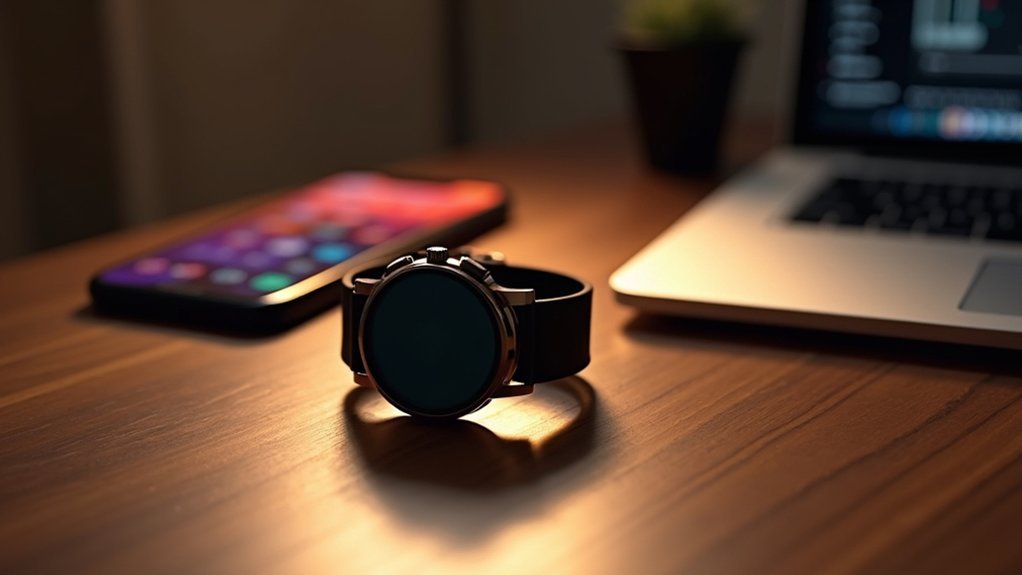
Leave a Reply